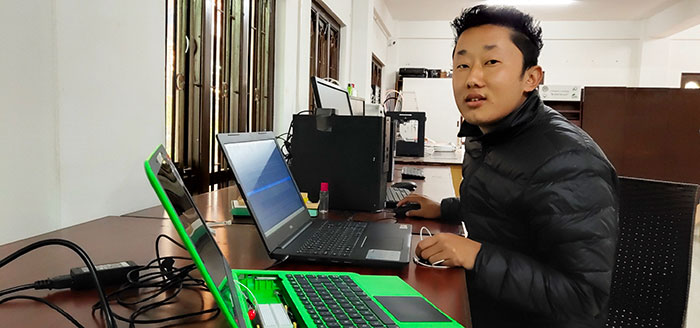Yangyel Lhaden
FabLab, Babesa, Thimphu – Signs, symbols and numbers on the dead-blue background. To the uninitiated eyes, a meaningless patchwork of letters and arcane hogwash.
Not for Sangay Rinchen. He’s very close to understanding how it all works, what magic combination of these numbers—codes in computer language—can bring him closer to achieving his dream.
After completing his higher secondary education, Sangay could have enrolled in Sustainable Development course at the College of Natural Resources. He didn’t. He would not have come so far with his dream of making a smart walking stick (SWS) “Karma for All” otherwise.
Born with ligament contraction, Sangay walks on his knees. He went to school later, at the age of 11; both his parents feared social stigma and could not decide on sending Sangay to school. Were it not for Yeshi Choki, a teacher, Sangay would have never gone to school.
In love with machines and technology
A friend gave Sangay a motor to play with. That was before he went to school. He connected the motor to a battery and was fascinated by it. He figured what interested him and what he wanted to do when he grew up.
An Arts student, Sangay would be seen taking part in science exhibitions. Every body in school knew where to find Sangay. He would be in the IT Lab learning about robotics, motherboard or microprocessor from YouTube. Even then, he knew fair bit about programming and coding.
One time when Sangay was in Class XI, in 2018, his chemistry teacher encouraged him to build a project for National STEM Olympics. He did. Sangay’s basket-weaving machine made to 11th out of 20-something projects.
Friends remember Sangay’s father who would carry his son on his back up to the stage to receive certificate of excellence. That happened often because Sangay was a bright student and used to top his class every year.
When he was in Class IV, as part of science exhibition Sangay designed a light-sensor remote car and a green house with modified sensor with hydraulic pump when he was in Class IX. The solar panel stored excess solar energy during the day. The saved photons helped plants photosynthesise at night.
Another time he made a drone that could hover about a metre high from the ground. When not snowed under with assignments and schoolwork, Sangay would be seen scavenging small machine parts in the hardware shops.
“Everything is useful. If a part doesn’t work here, it will for something else somewhere,” says Sangay, who damaged two TVs and a refrigerator hunting for sensors for his wild projects. While in school, Sangay got a bicycle which he rendered to bare frames to study how gears worked. He put them all back and learnt to ride.
Project “Karma for All”
When Karma Lhakyi, managing director of FabLab Bhutan, first met Sangay at National STEM Olympics, she was intrigued by Sangay’s passion and his desire to learn. What he wanted to invent was almost novel, to give voice command to walking stick for the visually impaired.
Basically, the stick will alert obstacles and distance. The stick can even tell the user how big the obstacle is. For this project, Sangay got a micro grant from Royal Thimphu College.
“I haven’t met anyone like Sangay,” said Karma Lhakyi. “He is curious and always eager to learn.”
After developing the prototype of the stick, Sangay will soon leave for Denmark and Japan to work on his final project.
“I never had a laptop,” says Sangay. “Now I have two.” He is in the second phase of building the prototype. Almost forty percent of the work has been completed.
Beyond SWS
Sangay has been at the FabLab for two months now and is learning coding and programming virtually from tutors in India.
Sangay may be paralysed from knee down but he wants to drive a car. To understand the mechanics of a car Sangay worked at a car workshop for about a month after high school. In fact, he can drive but wants to adjust the pressure of hydraulic jack so that he does not have to put too much pressure on clutch and break. He has a design ready for that.
How did you learn to drive?
From YouTube. Sangay learnt the driving basics from YouTube and tried his hand behind the wheel upon a night.
“Once you know how the machines and their parts work, it is easy,” says Sangay. “I want to drive and be independent.”
But, for Sangay, getting a driving licence could perhaps prove to be a challenge like he never faced.
“The RSTA officials said they had no problem in issuing licence but recommended me to submit a letter to Gross National Happiness Commission for approval,” Sangay, upbeat and positive. “Do you think it’s going to be a problem?”


